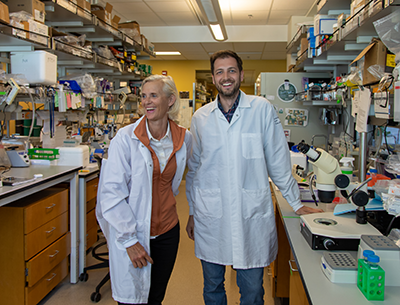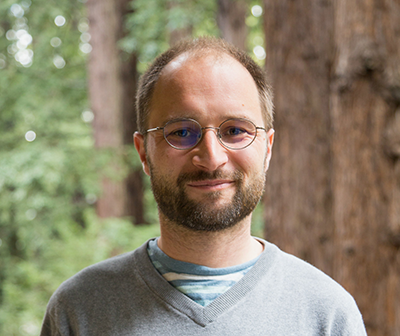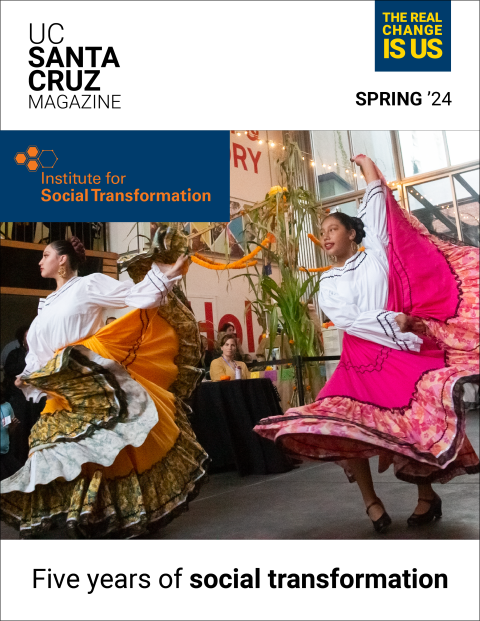The California Institute for Regenerative Medicine (CIRM) will provide more than $2.6 million in total funding for two major stem cell research projects led by scientists at UC Santa Cruz, the organization announced.
One of the two projects will be led by Professor of Biomolecular Engineering and Director of the UCSC Institute for the Biology of Stem Cells (IBSC) Camilla Forsberg and Bryce Manso, a postdoctoral scholar in her lab. The second will be led by Max Haeussler, Associate Research Scientist at the UCSC Genomics Institute.
Examining platelets and aging
Forsberg and Manso’s project will study the connection between aging and platelet production among the human population. Platelets are small blood cells whose primary function is to form clots to prevent bleeding. The researchers will address gaps in the scientific understanding of how changes to age-related platelet production can lead to blood clots, stroke, and cardiovascular disease. This research could lead to improved treatment strategies for the millions of Americans who take drugs to prevent these health risks.
The project, titled “Determining how age-specific heterogeneity of human hematopoietic stem cells and megakaryocyte progenitors contribute to thrombotic disease upon aging,” was awarded $1,536,000 in funding.
“We are thrilled to receive funding from CIRM to explore how aging changes platelet production among the human population,” Manso said. “Age-related changes to platelets contribute to and drive a myriad of diseases, resulting in morbidity and mortality of the elderly. Over the next several years, we will leverage studies at the cellular and molecular level to reveal why this happens and explore potential routes of clinical intervention."
“The research translates animal model discoveries from my lab into research critical for human health,” Forsberg said. “From a training perspective, it is very satisfying that the grant proposal was pioneered by Bryce Manso, who is funded by a National Institutes of Health IRACDA training grant to our IBSC. This success story shows how world-class training programs attract exceptional talent to UC Santa Cruz.”
Additional contributors to this proposal include Saran Chattopadhyaya and Stephanie Smith-Berdan of the Forsberg lab, Professor of Biomolecular Engineering and IBSC member Joshua Stuart, staff researcher in Stuart’s lab Chris Wong, and Stanford University collaborators Charles Kwok Fai Chan and Ravindra Majeti.
‘Virtual microscope’ for single cell RNA-sequencing data
For Haeussler’s project, he and his team will build a user-friendly database that brings together a wide range of single cell RNA-sequencing data, which reveals information about the gene expression levels of an individual cell, from the developing and diseased human cerebral cortex. The database is imagined as a “virtual microscope” which will improve the curation and visualization of this data and allow scientists to investigate the role of a specific gene in the development of the cerebral cortex without special computational training.
The database will support spatial transcriptomics data, an emerging technique for determining the relative location of a given cell within the tissue. Users will be able to compare single cell RNA-sequencing data with spatial transcriptomic information to those without spatial transcriptomic information, increasing the ability to compare previously produced data to newer data.
The database will be hosted on the Genomics Institute’s existing cell browser platform, a free, open-source tool used by researchers and pharmaceutical companies around the world.
Two Genomics Institute staff members will collect existing data on gene activity in the human brain from researchers across the world and make it accessible in the interactive map viewer that Haeussler has been developing for the last five years. Aparna Bhaduri, Haeussler’s collaborator at UCLA for this grant, will produce new spatial data to add to this collection.
"After years of searching, I'm excited to get funding for this software project,” Haeussler said. “Already several thousand researchers every week are consulting this interactive explorer of gene activity. The CIRM funding allows us to add several hundred datasets in the human brain, it will be the first brain-focussed gene activity explorer that hosts datasets from different labs across the world and as such from a broad diversity of patients"
This project is titled “An interactive data resource for hypothesis testing in stem cell single-cell gene expression and validation of the results with brain organoids,” and was awarded $1,160,126 in funding.
These awards are among the seventeen new projects throughout the state for which CIRM is investing $26 million in total funding. They are part of CIRM’s DISC-0: Foundation Awards Program, which supports rigorous studies addressing critical basic knowledge gaps in the biology of stem cells and regenerative medicine approaches and to advance stem cell-based tools.
Two major stem cell research projects supported with more than $2.6 million in funding




